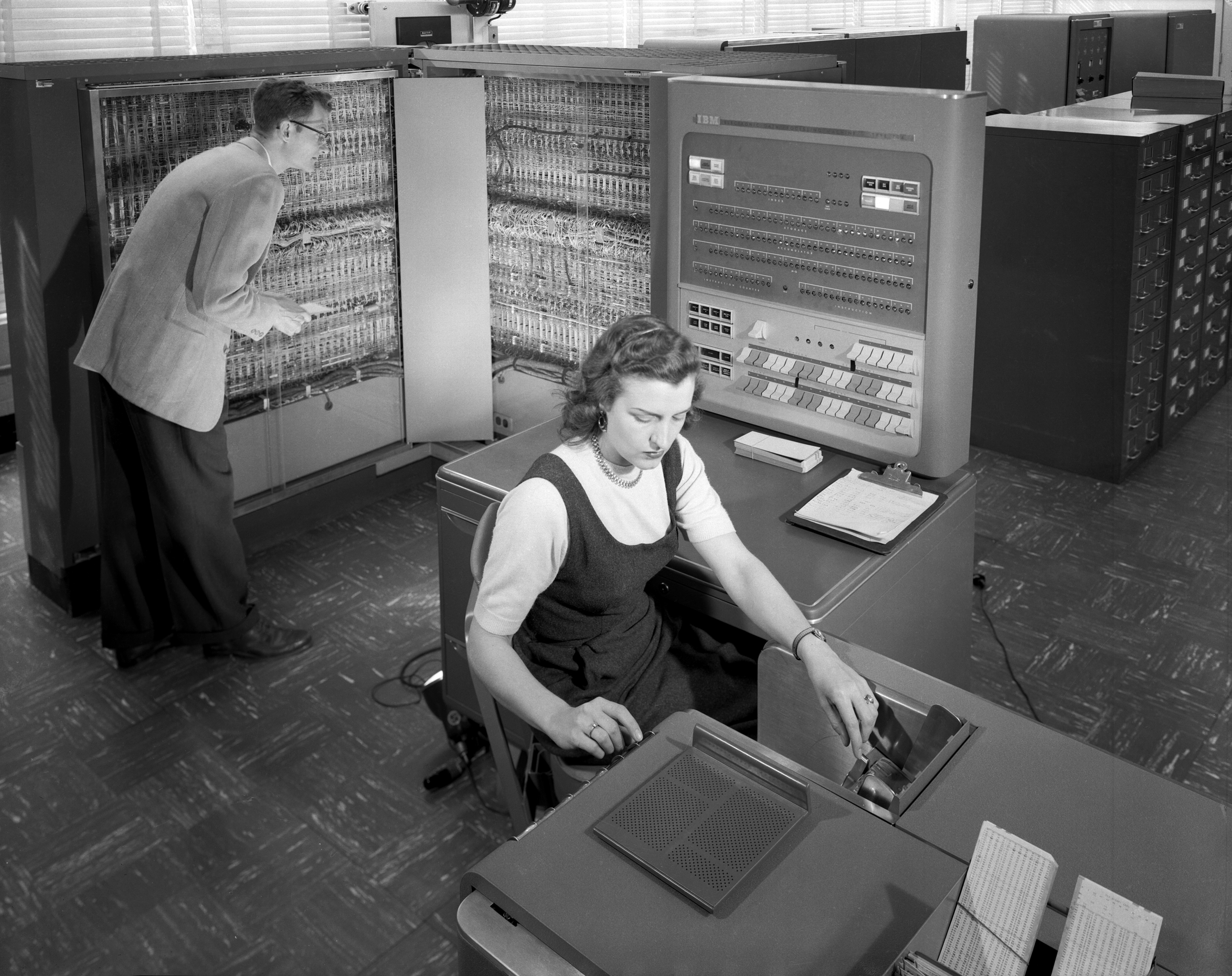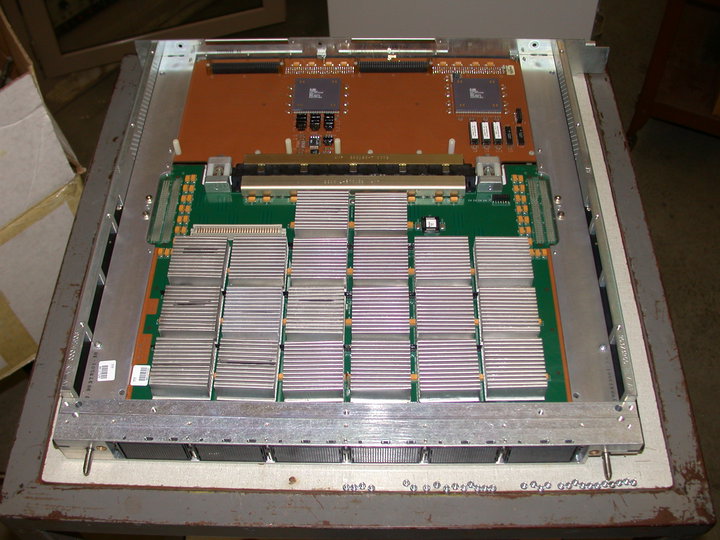|
Supercomputing
A supercomputer is a type of computer with a high level of performance as compared to a general-purpose computer. The performance of a supercomputer is commonly measured in floating-point operations per second (FLOPS) instead of million instructions per second (MIPS). Since 2022, supercomputers have existed which can perform over 1018 FLOPS, so called Exascale computing, exascale supercomputers. For comparison, a desktop computer has performance in the range of hundreds of gigaFLOPS (1011) to tens of teraFLOPS (1013). Since November 2017, all of the TOP500, world's fastest 500 supercomputers run on Linux-based operating systems. Additional research is being conducted in the United States, the European Union, Taiwan, Japan, and China to build faster, more powerful and technologically superior exascale supercomputers. Supercomputers play an important role in the field of computational science, and are used for a wide range of computationally intensive tasks in various fields, ... [...More Info...] [...Related Items...] OR: [Wikipedia] [Google] [Baidu] [Amazon] |
TOP500
The TOP500 project ranks and details the 500 most powerful non-distributed computing, distributed computer systems in the world. The project was started in 1993 and publishes an updated list of the supercomputers twice a year. The first of these updates always coincides with the International Supercomputing Conference in June, and the second is presented at the ACM/IEEE Supercomputing Conference in November. The project aims to provide a reliable basis for tracking and detecting trends in high-performance computing and bases rankings on HPL (benchmark), HPL benchmarks, a portable implementation of the high-performance LINPACK benchmarks, LINPACK benchmark written in Fortran for Distributed memory, distributed-memory computers. The most recent edition of TOP500 was published in June 2025 as the 65th edition of TOP500, while the next edition of TOP500 will be published in November 2025 as the 66th edition of TOP500. As of June 2025, the United States' El Capitan (supercomputer), El ... [...More Info...] [...Related Items...] OR: [Wikipedia] [Google] [Baidu] [Amazon] |
Exascale Computing
Exascale computing refers to Computer system, computing systems capable of calculating at least 1018 IEEE 754 Double Precision (64-bit) operations (multiplications and/or additions) per second (exaFLOPS)"; it is a measure of supercomputer performance. Exascale computing is a significant achievement in computer engineering: primarily, it allows improved scientific applications and better prediction accuracy in domains such as weather forecasting, climate modeling and personalised medicine. Exascale also reaches the estimated processing power of the human brain at the neural level, a target of the now defunct Human Brain Project. There has been a race to be the first country to build an exascale computer, typically ranked in the TOP500 list. In 2022, the world's first public exascale computer, Frontier (supercomputer), Frontier, was announced. , Lawrence Livermore National Laboratory's El Capitan (supercomputer), El Capitan is the world's fastest exascale supercomputer. Definiti ... [...More Info...] [...Related Items...] OR: [Wikipedia] [Google] [Baidu] [Amazon] |
Cray Research
Cray Inc., a subsidiary of Hewlett Packard Enterprise, is an American supercomputer manufacturer headquartered in Seattle, Washington. It also manufactures systems for data storage and analytics. Several Cray supercomputer systems are listed in the TOP500, which ranks the most powerful supercomputers in the world. In 1972, the company was founded by computer designer Seymour Cray as Cray Research, Inc., and it continues to manufacture parts in Chippewa Falls, Wisconsin, where Cray was born and raised. After being acquired by Silicon Graphics in 1996, the modern company was formed after being purchased in 2000 by Tera Computer Company, which adopted the name Cray Inc. In 2019, the company was acquired by Hewlett Packard Enterprise for $1.3 billion. History Background: 1950–1972 In 1950, Seymour Cray began working in the computing field when he joined Engineering Research Associates (ERA) in Saint Paul, Minnesota. There, he helped to create the ERA 1103. ERA eventually became ... [...More Info...] [...Related Items...] OR: [Wikipedia] [Google] [Baidu] [Amazon] |
FLOPS
Floating point operations per second (FLOPS, flops or flop/s) is a measure of computer performance in computing, useful in fields of scientific computations that require floating-point calculations. For such cases, it is a more accurate measure than measuring instructions per second. Floating-point arithmetic Floating-point arithmetic is needed for very large or very small real numbers, or computations that require a large dynamic range. Floating-point representation is similar to scientific notation, except computers use base two (with rare exceptions), rather than base ten. The encoding scheme stores the sign, the exponent (in base two for Cray and VAX, base two or ten for IEEE floating point formats, and base 16 for IBM Floating Point Architecture) and the significand (number after the radix point). While several similar formats are in use, the most common is ANSI/IEEE Std. 754-1985. This standard defines the format for 32-bit numbers called ''single precision'', a ... [...More Info...] [...Related Items...] OR: [Wikipedia] [Google] [Baidu] [Amazon] |
Seymour Cray
Seymour Roger Cray (September 28, 1925 – October 5, 1996) – was an American and architect who designed a series of computers that were the fastest in the world for decades, and founded Cray Research, which built many of these machines. Called "the father of supercomputing", Cray has been credited with creating the supercomputer industry. Joel S. Birnbaum [...More Info...] [...Related Items...] OR: [Wikipedia] [Google] [Baidu] [Amazon] |
Cray-1
The Cray-1 was a supercomputer designed, manufactured and marketed by Cray Research. Announced in 1975, the first Cray-1 system was installed at Los Alamos National Laboratory in 1976. Eventually, eighty Cray-1s were sold, making it one of the most successful supercomputers in history. It is perhaps best known for its unique shape, a relatively small C-shaped cabinet with a ring of benches around the outside covering the power supplies and the cooling system. The Cray-1 was the first supercomputer to successfully implement the vector processor design. These systems improve the performance of math operations by arranging memory and registers to quickly perform a single operation on a large set of data. Previous systems like the CDC STAR-100 and ASC had implemented these concepts but did so in a way that seriously limited their performance. The Cray-1 addressed these problems and produced a machine that ran several times faster than any similar design. The Cray-1's architect ... [...More Info...] [...Related Items...] OR: [Wikipedia] [Google] [Baidu] [Amazon] |
Control Data Corporation
Control Data Corporation (CDC) was a mainframe and supercomputer company that in the 1960s was one of the nine major U.S. computer companies, which group included IBM, the Burroughs Corporation, and the Digital Equipment Corporation (DEC), the NCR Corporation (NCR), General Electric, Honeywell, RCA, and UNIVAC. For most of the 1960s, the strength of CDC was the work of the electrical engineer Seymour Cray who developed a series of fast computers, then considered the fastest computing machines in the world; in the 1970s, Cray left the Control Data Corporation and founded Cray Research (CRI) to design and make supercomputers. In 1988, after much financial loss, the Control Data Corporation began withdrawing from making computers and sold the affiliated companies of CDC; in 1992, CDC established Control Data Systems, Inc. The remaining affiliate companies of CDC currently do business as the software company Dayforce. Background: World War II – 1957 During World War II the Un ... [...More Info...] [...Related Items...] OR: [Wikipedia] [Google] [Baidu] [Amazon] |
Million Instructions Per Second
Instructions per second (IPS) is a measure of a computer's processor speed. For complex instruction set computers (CISCs), different instructions take different amounts of time, so the value measured depends on the instruction mix; even for comparing processors in the same family the IPS measurement can be problematic. Many reported IPS values have represented "peak" execution rates on artificial instruction sequences with few branches and no cache contention, whereas realistic workloads typically lead to significantly lower IPS values. Memory hierarchy also greatly affects processor performance, an issue barely considered in IPS calculations. Because of these problems, synthetic benchmarks such as Dhrystone are now generally used to estimate computer performance in commonly used applications, and raw IPS has fallen into disuse. The term is commonly used in association with a metric prefix (k, M, G, T, P, or E) to form kilo instructions per second (kIPS), mega instructio ... [...More Info...] [...Related Items...] OR: [Wikipedia] [Google] [Baidu] [Amazon] |
Parallel Computing
Parallel computing is a type of computing, computation in which many calculations or Process (computing), processes are carried out simultaneously. Large problems can often be divided into smaller ones, which can then be solved at the same time. There are several different forms of parallel computing: Bit-level parallelism, bit-level, Instruction-level parallelism, instruction-level, Data parallelism, data, and task parallelism. Parallelism has long been employed in high-performance computing, but has gained broader interest due to the physical constraints preventing frequency scaling.S.V. Adve ''et al.'' (November 2008)"Parallel Computing Research at Illinois: The UPCRC Agenda" (PDF). Parallel@Illinois, University of Illinois at Urbana-Champaign. "The main techniques for these performance benefits—increased clock frequency and smarter but increasingly complex architectures—are now hitting the so-called power wall. The computer industry has accepted that future performance inc ... [...More Info...] [...Related Items...] OR: [Wikipedia] [Google] [Baidu] [Amazon] |
Central Processing Unit
A central processing unit (CPU), also called a central processor, main processor, or just processor, is the primary Processor (computing), processor in a given computer. Its electronic circuitry executes Instruction (computing), instructions of a computer program, such as arithmetic, logic, controlling, and input/output (I/O) operations. This role contrasts with that of external components, such as main memory and I/O circuitry, and specialized coprocessors such as graphics processing units (GPUs). The form, CPU design, design, and implementation of CPUs have changed over time, but their fundamental operation remains almost unchanged. Principal components of a CPU include the arithmetic–logic unit (ALU) that performs arithmetic operation, arithmetic and Bitwise operation, logic operations, processor registers that supply operands to the ALU and store the results of ALU operations, and a control unit that orchestrates the #Fetch, fetching (from memory), #Decode, decoding and ... [...More Info...] [...Related Items...] OR: [Wikipedia] [Google] [Baidu] [Amazon] |
IBM Blue Gene P Supercomputer
International Business Machines Corporation (using the trademark IBM), nicknamed Big Blue, is an American Multinational corporation, multinational technology company headquartered in Armonk, New York, and present in over 175 countries. It is a publicly traded company and one of the 30 companies in the Dow Jones Industrial Average. IBM is the largest industrial research organization in the world, with 19 research facilities across a dozen countries; for 29 consecutive years, from 1993 to 2021, it held the record for most annual U.S. patents generated by a business. IBM was founded in 1911 as the Computing-Tabulating-Recording Company (CTR), a holding company of manufacturers of record-keeping and measuring systems. It was renamed "International Business Machines" in 1924 and soon became the leading manufacturer of Tabulating machine, punch-card tabulating systems. During the 1960s and 1970s, the IBM mainframe, exemplified by the IBM System/360, System/360 and its successors, wa ... [...More Info...] [...Related Items...] OR: [Wikipedia] [Google] [Baidu] [Amazon] |
Vector Processor
In computing, a vector processor or array processor is a central processing unit (CPU) that implements an instruction set where its instructions are designed to operate efficiently and effectively on large one-dimensional arrays of data called ''vectors''. This is in contrast to scalar processors, whose instructions operate on single data items only, and in contrast to some of those same scalar processors having additional single instruction, multiple data (SIMD) or SIMD within a register (SWAR) Arithmetic Units. Vector processors can greatly improve performance on certain workloads, notably numerical simulation, compression and similar tasks. Vector processing techniques also operate in video-game console hardware and in graphics accelerators. Vector machines appeared in the early 1970s and dominated supercomputer design through the 1970s into the 1990s, notably the various Cray platforms. The rapid fall in the price-to-performance ratio of conventional microprocessor de ... [...More Info...] [...Related Items...] OR: [Wikipedia] [Google] [Baidu] [Amazon] |








